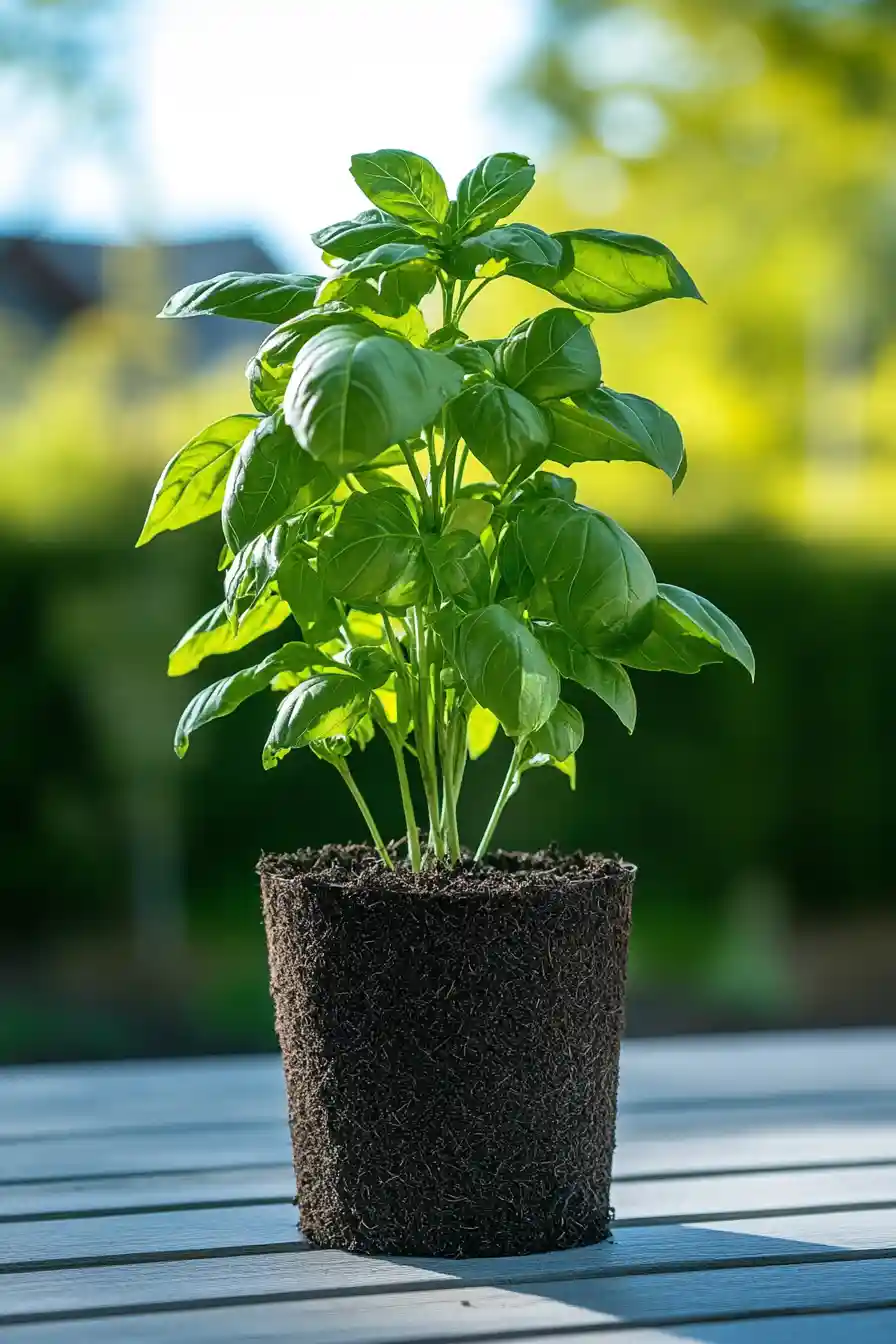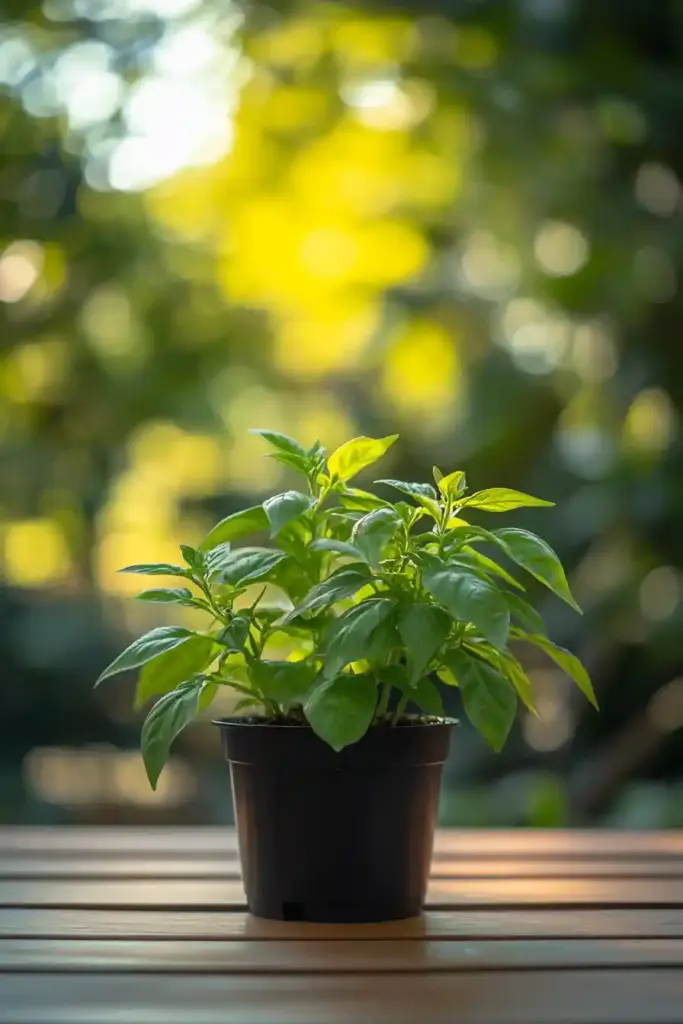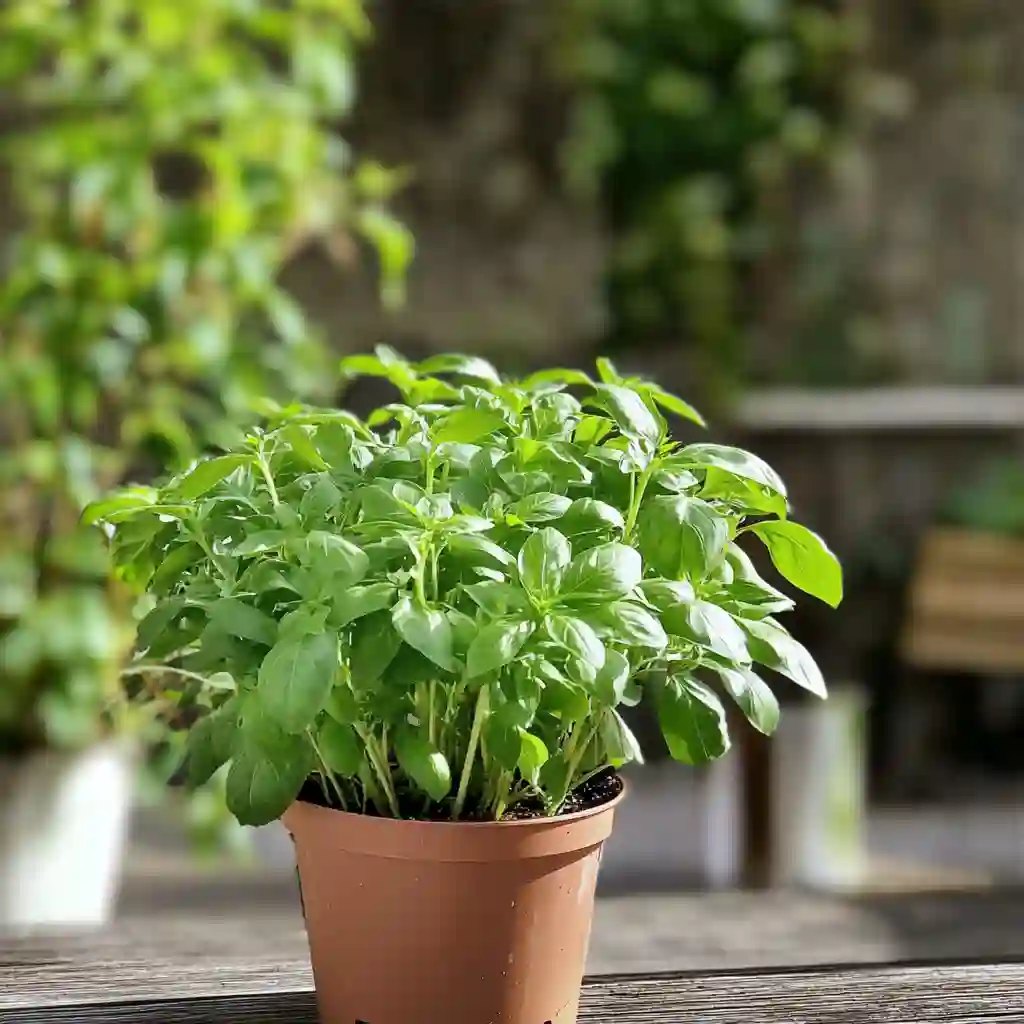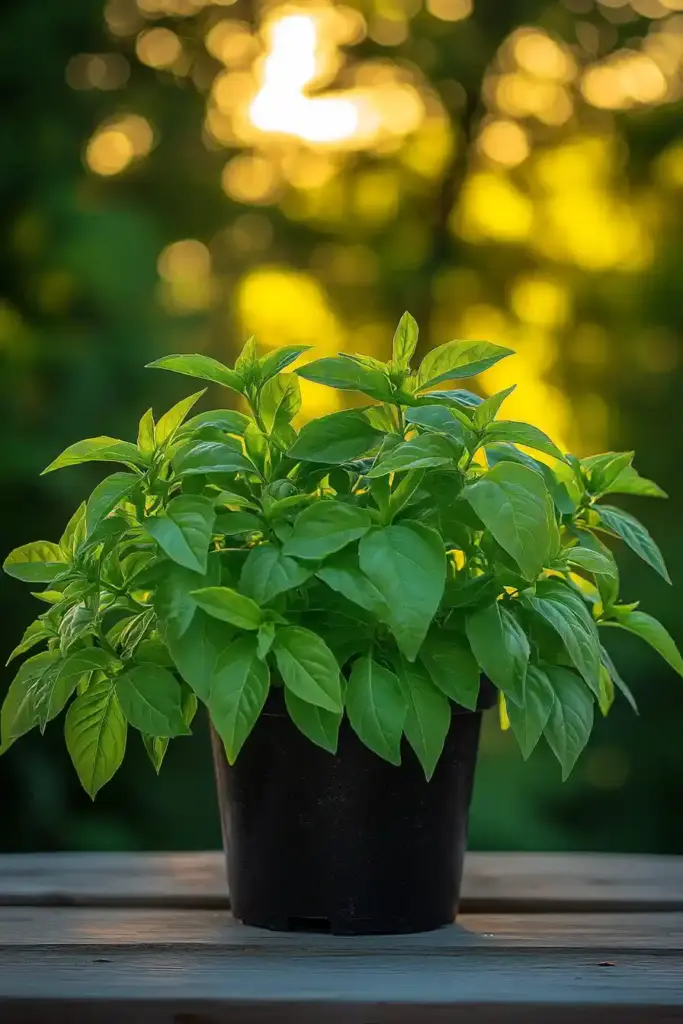Growing basil is one of the most rewarding experiences for home gardeners and culinary enthusiasts alike. This fragrant, leafy herb not only enhances the taste of your dishes but also brings pollinators and a burst of greenery to your garden space. Whether you’re growing basil indoors in containers or planting it outdoors in raised beds or garden rows, this herb thrives with the right care.
In this guide on growing basil: planting & care tips, you’ll learn everything from soil preparation and planting methods to harvesting, pruning, and managing pests. Our goal is to help you grow thriving basil plants that are lush, aromatic, and full of flavor all season long.
Quick Facts & Botanical Insights
Before you start growing basil, it helps to understand a bit about what makes this herb so special. Basil (Ocimum basilicum) belongs to the mint family (Lamiaceae) and is native to tropical regions from central Africa to Southeast Asia. It’s an annual plant in most climates, though in warm, frost-free regions, it can behave like a short-lived perennial.
Here’s a quick glance at the essentials:
🌿 Quick Facts About Basil:
- Botanical Name: Ocimum basilicum
- Common Names: Sweet basil, Genovese basil, culinary basil
- Plant Type: Tender annual herb (perennial in tropical climates)
- Mature Height: 12–24 inches (varies by variety)
- Sunlight Needs: Full sun (6–8 hours daily)
- Soil pH: 6.0 to 7.0
- Soil Type: Nutrient-rich, well-draining loam
- Water Needs: Moderate; keep soil consistently moist but not soggy
- Companion Plants: Tomatoes, peppers, asparagus, oregano, marigolds
🌱 Notable Varieties to Consider:
- ‘Genovese’ Basil – Classic Italian flavor, large leaves, great for pesto
- ‘Thai Basil’ – Spicy anise flavor, purple stems, excellent in stir-fries
- ‘Lemon’ or ‘Lime Basil’ – Citrus-scented leaves ideal for teas and desserts
- ‘Dark Opal’ Basil – Deep purple foliage, ornamental and edible
- ‘Greek Minette’ Basil – Compact, globe-shaped variety with small leaves
Basil’s fast growth and wide range of flavors make it a must-have in the herb garden. In the next section, we’ll break down the ideal growing conditions so your basil can thrive from seedling to harvest.
Ideal Growing Conditions for Basil
To grow lush, healthy basil, it’s essential to provide the right environment. From sunlight to soil, basil is a bit particular—but once you meet its needs, it will reward you with a steady supply of flavorful leaves.

☀️ Light Requirements
- Basil loves the sun. Aim to provide 6 to 8 hours of full sunlight daily.
- In hot climates, light afternoon shade can prevent leaf scorching.
- If growing indoors, use a south-facing window or supplement with grow lights for at least 12 hours a day.
🌡️ Temperature & Climate
- Basil thrives in warm weather. Ideal daytime temps range from 70–90°F (21–32°C).
- Soil temperature should be at least 70°F (21°C) for seed germination.
- Never plant basil outside until after the last frost; this herb is extremely frost-sensitive.
- If a cold snap is forecasted, protect your plants with frost cloths or row covers.
🌱 Soil Preferences
- Basil needs nutrient-rich, loamy, and well-draining soil.
- Ideal pH: 6.0 to 7.0
- Amend your soil with compost or well-rotted manure before planting.
- Raised beds and containers are excellent choices for maintaining soil quality and drainage.
💧 Watering Basil
- Keep soil consistently moist but not soggy. Overwatering can cause root rot.
- Water at the base of the plant to keep leaves dry and prevent fungal issues.
- During hot spells, check daily and water more frequently if the top inch of soil is dry.
🌿 Mulching & Moisture Control
- Apply 1–2 inches of organic mulch (like straw or leaf mold) around plants.
- Mulch helps retain soil moisture, regulate soil temperature, and suppress weeds.
With the right conditions in place, your basil will grow rapidly and be ready for harvest in a matter of weeks. Next, we’ll walk you through exactly how to plant basil—whether you’re starting from seed or transplanting seedlings.
How to Plant Basil (Seeds & Transplants)

Whether you’re starting from scratch with seeds or picking up a few seedlings from your local nursery, basil is easy to establish. Follow these step-by-step instructions to set your plants up for success.
🌱 Starting Basil from Seed
Starting basil from seed is both economical and satisfying. Here’s how to do it right:
Indoor Seed Starting
- When: Start seeds 6 weeks before your last expected frost date.
- How:
- Fill seed trays or small pots with seed-starting mix.
- Plant seeds ¼ inch deep, lightly covering them with soil.
- Water gently to moisten the soil evenly.
- Keep the soil moist and maintain a temperature of 70–75°F (21–24°C).
- Seeds should germinate in 8–14 days.
- Once seedlings develop 2–3 sets of true leaves, thin or transplant them to give each plant room to grow.
Direct Sowing Outdoors
- When: Sow seeds directly after the last frost, when soil is warm (70°F+).
- How: Follow the same method as above, planting seeds in well-amended soil spaced every 2 inches. Thin to 12–18 inches apart once seedlings are 3–4 inches tall.
🌿 Transplanting Seedlings
If you’re transplanting basil starts (either your own or nursery-bought), follow these tips:
- Harden off seedlings by gradually exposing them to outdoor conditions over 5–7 days.
- Dig holes 12–18 inches apart in prepared garden beds, containers, or raised beds.
- Place each seedling at the same soil depth it was growing in its container.
- Backfill with soil, firm gently, and water thoroughly.
- Mulch around the base to conserve moisture and deter weeds.
💡 Pro Tip: Successive Plantings
To keep a steady supply of fresh basil throughout the growing season:
- Sow or transplant new basil plants every 2–3 weeks.
- This ensures you’ll always have vigorous, leafy plants ready for harvest.
Now that your basil is in the ground (or pots), it’s time to focus on how to keep it healthy and productive.
Maintenance & Ongoing Care for Basil
Once your basil is planted, keeping it healthy comes down to regular attention and smart garden habits. Basil is relatively low-maintenance, but a few key practices will help it flourish and deliver the best flavor.

✂️ Pruning for Productivity
Pruning basil isn’t just for looks—it’s essential for a bushy, high-yielding plant.
How to Prune:
- When to start: Once your basil plant has at least 6 sets of leaves.
- Technique: Snip the stem just above the second set of leaves from the bottom. This encourages side shoots and a fuller plant.
- Continue pruning every couple of weeks to keep the plant branching and delay flowering.
- Pinch off flower buds as soon as you see them. Once basil flowers, leaf production slows, and the flavor can become bitter.
💧 Watering Routine
- Basil enjoys even moisture, especially in the heat of summer.
- Check soil daily, and water when the top inch feels dry.
- Water at the base to prevent fungal diseases.
- Avoid wetting leaves in the evening to reduce the risk of mildew or rot.
🌿 Feeding Your Basil
Even though basil grows well in rich soil, it benefits from regular feeding.
- Use a balanced organic fertilizer (e.g., 5-5-5) every 2–3 weeks.
- Alternatively, you can side-dress plants with compost or worm castings.
- Avoid high-nitrogen fertilizers, which encourage foliage at the expense of flavor.
🪴 Container Care
If you’re growing basil in pots:
- Choose containers with good drainage.
- Use a light, well-draining potting mix enriched with compost.
- Water more frequently, as pots dry out faster—especially in hot weather.
- Consider using self-watering containers for consistent moisture.
🔄 Succession Planting
To keep your basil harvest going strong:
- Replant every 2–3 weeks during the growing season.
- As older plants begin to decline, newer ones will take their place, ensuring a continuous supply of fresh leaves.
Well-maintained basil plants can give you harvest after harvest for months. But even the healthiest plants need protection from a few common garden challenges.
Common Pests & Diseases (and Natural Solutions)
Even the most well-tended basil plants can fall prey to a few pests and diseases. The good news? With proactive care and organic methods, you can keep these issues under control without resorting to harmful chemicals.

🐛 Common Basil Pests & How to Handle Them
Aphids
- Symptoms: Curling leaves, sticky residue (honeydew), stunted growth.
- Solution:
- Spray leaves with a strong blast of water to knock them off.
- Introduce ladybugs or plant companion herbs like dill and fennel to attract beneficial predators.
- Use neem oil or insecticidal soap as a last resort.
Japanese Beetles
- Symptoms: Skeletonized leaves, clusters of shiny beetles on foliage.
- Solution:
- Hand-pick beetles and drop them into a jar of soapy water.
- Cover plants with fine mesh netting during peak beetle season.
- Companion planting with garlic or chives may help repel them.
Slugs and Snails
- Symptoms: Ragged holes in leaves, slime trails.
- Solution:
- Set out beer traps or copper tape around containers.
- Remove hiding spots like damp mulch or garden debris.
🌱 Common Basil Diseases & Prevention
Fusarium Wilt
- Symptoms: Wilting, yellowing, stunted growth, and dark streaks on stems.
- Solution:
- Remove and discard infected plants.
- Choose disease-resistant varieties (e.g., ‘Nufar’).
- Practice crop rotation and don’t plant basil in the same spot year after year.
- Water at the base to avoid splashing soil onto leaves.
Downy Mildew
- Symptoms: Yellowing leaves with grayish-purple fuzz on the undersides.
- Solution:
- Improve air circulation by proper spacing and pruning.
- Water early in the day so foliage dries before nightfall.
- Avoid overhead watering and remove infected leaves promptly.
Root Rot
- Symptoms: Wilting, yellowing, and mushy roots caused by overwatering or poor drainage.
- Solution:
- Ensure soil or containers drain well.
- Let soil dry slightly between waterings.
🌿 Preventative Tips for Healthier Basil
- Space plants properly (12–18 inches apart) for airflow.
- Mulch around the base to reduce splash-back and retain moisture.
- Use companion planting with pest-repelling herbs like oregano, borage, and marigold.
- Inspect your basil regularly—catching issues early is the best defense.
Harvesting & Using Your Basil

Harvesting basil at the right time—and in the right way—not only gives you the freshest, most flavorful leaves, but also helps your plant grow back stronger and more abundantly.
✂️ When to Harvest Basil
- Start harvesting once your plant reaches 6–8 inches in height and has developed several sets of true leaves.
- Basil matures around 68–75 days from sowing.
- The best time of day to harvest is early morning, when essential oil content is at its peak, giving you maximum flavor and aroma.
🌿 How to Harvest Basil Leaves
- Pinch or snip leaves just above a leaf pair to encourage branching.
- Harvest frequently—even daily—to keep the plant productive and prevent flowering.
- Avoid removing more than ⅓ of the plant at one time to keep it healthy.
💐 Prevent Flowering for Better Flavor
Once basil starts to flower, the leaves become smaller, tougher, and more bitter.
- Pinch off flower buds as soon as they appear.
- If your plant flowers and sets seed, its lifecycle ends much faster.
🧺 How to Store Basil
- Fresh use: Keep basil stems in a glass of water at room temperature, out of direct sunlight. Change water daily.
- Refrigeration: Not ideal—basil blackens in the cold.
- Freezing: Chop and freeze in ice cube trays with water or olive oil.
- Drying: Hang small bunches upside down in a well-ventilated area, but note that dried basil loses much of its flavor.
🍽️ Ways to Use Fresh Basil
- Pesto: Blend basil with pine nuts, garlic, olive oil, and Parmesan.
- Caprese salad: Pair with tomatoes and mozzarella.
- Herbal tea: Use lemon or lime basil for a citrusy twist.
- Infused oils or vinegars: Great for gifting or cooking.
With regular harvests, proper pruning, and ongoing care, basil can provide delicious leaves for weeks or even months. But before we wrap up, let’s talk about some extra expert tips and answer common questions new growers have.
Expert Tips & Basil FAQs

Now that you’ve got the basics (and then some!) down for growing basil, here are a few extra pointers to take your herb-growing skills to the next level—plus answers to some of the most frequently asked questions about basil care.
🌟 Expert Tips for Thriving Basil Plants
1. Grow Multiple Varieties
Try a mix of basil types—like Genovese, Thai, Lemon, and Purple—to explore different flavors and uses in your kitchen.
2. Companion Planting Wins
Grow basil near tomatoes, peppers, and asparagus to enhance flavor and deter common pests like aphids and hornworms.
3. Rotate Locations Each Year
Avoid planting basil in the same spot year after year to reduce the risk of soil-borne diseases like fusarium wilt.
4. Bring It Indoors
At the end of the season, pot up your healthiest plant and move it indoors to a sunny windowsill. Basil can grow indoors all year with enough light and warmth.
5. Boost Pollinators (Intentionally)
Let a few plants flower near the end of the season to attract bees and beneficial insects—just don’t let all of them go to seed too early.
❓ Frequently Asked Questions (FAQs)
Q: Why is my basil turning yellow?
A: Yellowing leaves can signal overwatering, poor drainage, or nutrient deficiency. Check your soil’s moisture and consider feeding with a balanced organic fertilizer.
Q: Can basil survive a light frost?
A: Not really. Even a light frost can damage or kill basil. Always plant after your last frost date and cover plants if a cold snap is expected.
Q: How often should I fertilize basil?
A: Every 2–3 weeks with an organic, balanced fertilizer. Over-fertilizing can reduce flavor, so go light and adjust based on plant vigor.
Q: Can I grow basil indoors year-round?
A: Yes! Use a sunny window or a full-spectrum grow light. Keep the temperature above 65°F, and ensure good airflow to avoid mildew.
Q: What’s the best way to preserve basil?
A: Freezing in olive oil (in ice cube trays) is one of the best ways to lock in flavor. Drying works too, but the flavor is more subtle.
Conclusion
Basil is more than just a kitchen staple—it’s a fragrant, fast-growing herb that adds color, flavor, and beneficial biodiversity to your garden. Whether you’re planting in pots on a patio or a raised bed in your backyard, success with basil starts with well-draining soil, plenty of sunlight, regular pruning, and a dash of care.
Here’s a quick recap to keep in mind:
- Plant basil in warm, sunny spots with nutrient-rich, slightly acidic soil.
- Water consistently, but avoid soggy roots.
- Prune early and often to boost yields and extend the growing season.
- Watch for pests like aphids and beetles, and use organic methods for control.
- Harvest often, and don’t let basil flower too early.
- Grow successively throughout the season for a continuous supply.
With these expert planting and care tips, your basil will thrive—and your kitchen will thank you.


